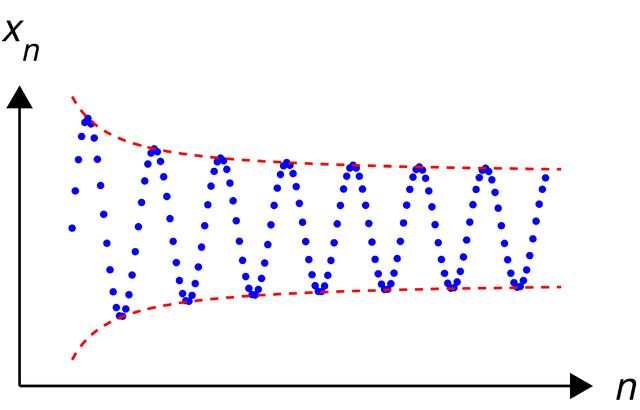
File:Cauchy sequence illustration2.png
- File
- File usage
- Find out about Schools Wikipedia

Size of this preview: 640 × 410 pixels.
| |
This is a file from the Wikimedia Commons. Information from its description page there is shown below.
Commons is a freely licensed media file repository. You can help. |
| Description | Illustration of en:Cauchy sequence |
| Date | 20:58, 3 June 2007 (UTC) |
| Source | self-made, with en:matlab |
| Author | Oleg Alexandrov |
| Permission ( Reusing this file) |
Public domain |
|
|
This chart was created with MATLAB. |
 |
File:Cauchy sequence illustration2.svg is a vector version of this file. It should be used in place of this raster image when superior. File:Cauchy sequence illustration2.png
For more information about vector graphics, read about Commons transition to SVG.
|
 |
| Public domainPublic domainfalsefalse |
 |
I, the copyright holder of this work, release this work into the public domain. This applies worldwide. In some countries this may not be legally possible; if so: I grant anyone the right to use this work for any purpose, without any conditions, unless such conditions are required by law. Public domainPublic domainfalsefalse |
Source code ( MATLAB)
% draw an illustration of a sequence that is not Cauchy function main() % prepare the screen and define some parameters figure(1); clf; hold on; axis equal; axis off; fontsize=30; thick_line=3; thin_line=2; black=[0, 0, 0]; red=[1, 0, 0]; blue=[0, 0, 1]; arrowsize=0.5; arrow_type=1; arrow_angle=30; % (angle in degrees) circrad=0.07; % radius of ball showing up in places B=9; X=0:0.06:B; f=inline('(X+2)./(X+0.8)', 'X'); Y=sin(5*X).*f(X); for i=1:length(X) ball(X(i), Y(i), circrad, blue); end X=0:0.05:(B+0.3); Z=f(X); plot(X, Z, 'r--', 'linewidth', thin_line) plot(X, -Z, 'r--', 'linewidth', thin_line) % draw the coordinate axes shift=-3; Kx=1.1; Ky=1.3; L=max(Y); arrow([-1 shift], [Kx*B, shift], thin_line, arrowsize, arrow_angle, arrow_type, black) arrow([-1, shift], [-1, Ky*L], thin_line, arrowsize, arrow_angle, arrow_type, black) text(Kx*B+0.6, shift, '\it{n}', 'fontsize', fontsize, 'HorizontalAlignment', 'c') text(-1, Ky*L+0.8, '\it{x_n}', 'fontsize', fontsize, 'HorizontalAlignment', 'c') % save to disk saveas(gcf, 'Cauchy_sequence_illustration2.eps', 'psc2') % export to eps function ball(x, y, r, colour) Theta=0:0.1:2*pi; X=r*cos(Theta)+x; Y=r*sin(Theta)+y; H=fill(X, Y, colour); set(H, 'EdgeColor', 'none'); function arrow(start, stop, th, arrow_size, sharpness, arrow_type, colour) % Function arguments: % start, stop: start and end coordinates of arrow, vectors of size 2 % th: thickness of arrow stick % arrow_size: the size of the two sides of the angle in this picture -> % sharpness: angle between the arrow stick and arrow side, in degrees % arrow_type: 1 for filled arrow, otherwise the arrow will be just two segments % color: arrow colour, a vector of length three with values in [0, 1] % convert to complex numbers i=sqrt(-1); start=start(1)+i*start(2); stop=stop(1)+i*stop(2); rotate_angle=exp(i*pi*sharpness/180); % points making up the arrow tip (besides the "stop" point) point1 = stop - (arrow_size*rotate_angle)*(stop-start)/abs(stop-start); point2 = stop - (arrow_size/rotate_angle)*(stop-start)/abs(stop-start); if arrow_type==1 % filled arrow % plot the stick, but not till the end, looks bad t=0.5*arrow_size*cos(pi*sharpness/180)/abs(stop-start); stop1=t*start+(1-t)*stop; plot(real([start, stop1]), imag([start, stop1]), 'LineWidth', th, 'Colour', colour); % fill the arrow H=fill(real([stop, point1, point2]), imag([stop, point1, point2]), colour); set(H, 'EdgeColor', 'none') else % two-segment arrow plot(real([start, stop]), imag([start, stop]), 'LineWidth', th, 'Colour', colour); plot(real([stop, point1]), imag([stop, point1]), 'LineWidth', th, 'Colour', colour); plot(real([stop, point2]), imag([stop, point2]), 'LineWidth', th, 'Colour', colour); end
Find out about Schools Wikipedia
Schools Wikipedia has been carefully checked to give you the best learning experience. SOS Children cares for children who have lost their parents. Our Children's Villages give these children a new home and a new family, while a high-quality education and the best of medical care ensures they will grow up with all they need to succeed in adult life. We have helped children in Africa for many years - you can help too...
